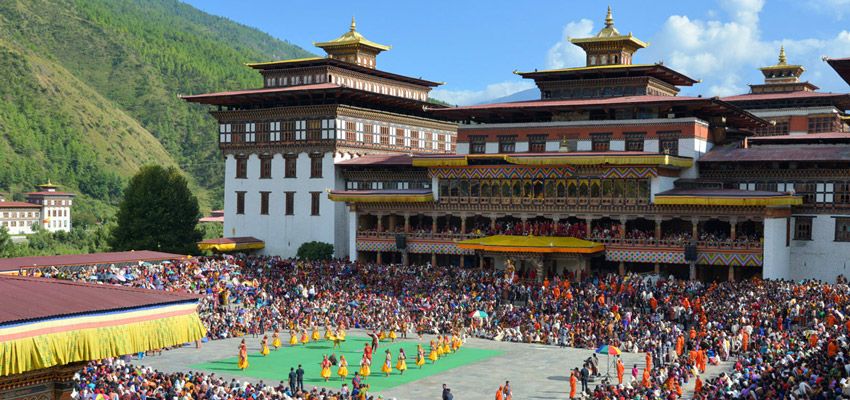Thimphu Tshechu starts on the 10th day of the 8th lunar month. The three-day religious event plays an important role in the lives of Bhutanese people as it is an opportunity for the Buddhist followers to immerse and cleanse themselves of the bad Karma and to remind them of what to make of their lives.
Staying true to the age-old tradition, locals dressed in their finest outfit and jewelries gather at the Thimphu Tashichoedzong. This spiritual social event brings people together unified by the common culture, tradition, and beliefs. The sacred mask dance (Chham) is believed to invoke deities blessing all who witness the Chham.
A Tsechu is performed as a tribute to Guru Rimpoche, a great Buddhist master who brought Buddhism to Bhutan. Sources say Guru Rimpoche healed a king called Sindhu Raja by performing eight forms of dances representing eight manifestations of Padmasambhava in the Bumthang Valley to restore the health of the king. These became the Chham dances depicting the grandeur of Padmasambhava which are now performed by monks and laymen.
The monks perform a series of meticulously choreographed religion inspired dances wearing grand silk robes and exquisitely crafted mask. It takes years learning and mastering the art of mask dance and months of meticulous practicing and rehearsing for the grand event.
The three-day event presents a collection of age-old Chham which includes Dance of the Stag and the Hounds, Dance of the Lords of the cemetery and the theatrical presentation of the judgment day after a person dies which are quintessential Buddhist beliefs and the Dance of Eight Manifestations of Padmasambhava.
Day 1 Highlights
Shawo Shachi, Dance of the Stag and the Hounds is a biographic drama inspired by the legacy of an eleventh-century Tibetan yogi Jetsun Milarepa. The dance illustrates the encounter of the saint and a hunter Gonpo Dorje who was converted to a compassionate Buddhist by the wise and compassionate saint.
The dance is presented as the hunter Gonpo Dorje and his hunting hounds chase after a terrified stag where they encounter the meditating saint and the saint sings songs of compassion and realization which calms the stag and the hound and they submit to Milarepa’s feet which infuriates the hunter even more and shoots his arrows at the saint, to his bewilderment the arrows snap three times. The compassionate saint sings his song of realization and the hunter moved submits himself at the feet of Milarepa. This dance demonstrates compassion and forgiveness which are an important aspect of Buddhist beliefs.
Day 2 Highlights
The Durdag chham, the dance of the lords of the cemetery is performed by 4 dancers wearing white skeletal costume and skull mask. The Chham is illustrated by these 4 dancers marching into the courtyard with thunderbolt steps to summon all negative forces. Dancers bend backward touching the ground by the tip of their masks as an act of summoning the deities of the earth to witness their act of faith. This dance is performed as a reminder of impermanence.
Day 3 Highlights
The Bardo Raksha Mangcham, the dance of Judgment of the dead is a representation of the judgment day after a person dies. It is believed that the departed consciousness of the deceased wanders for 7 weeks. During that intermediary state, the deceased is presented before the Lord of Death where the Black Demon and the White God reports the bad and good deeds of the deceased to the Lord of the Death for verdict. After an unrelenting debate, the Lord of Death passes the verdict. The sinner is dragged to hell and the spiritual is escorted by Dakinis for a favorable rebirth.
The Dance of Eight Manifestations of Padmasambhava is a biographical dance which represents 8 forms of Guru Padmasambhava where 6 are peaceful and 2 are wrathful forms.
The three-day Tsechu concludes with the unfurling of appliqué Thongdrol of Guru Rinpoche. Thongdrol means liberation at sight.
Aside from the main event, the Norzin lam in the capital city of Thimphu gets flooded with local residents drawn to the makeshift market. Vendors sell clothes, food and some organize games to celebrate the festival. Local concerts are performed in the heart of the city at The Clock Tower Square.





